Here at Fern Gardening, we are obviously big fans of ferns. However, we are also open-minded enough to accept that some people may have doubts about whether ferns are right for them. It’s fair to say that some ferns have a reputation for being difficult to keep alive. For those starting out, it’s not unreasonable to wonder if ferns make good houseplants.
Ferns can add a distinctive, tropical look to your home. Many evergreen varieties are easy to grow and maintain, and can bring color and beauty to the darker corners of the house, where other plants struggle. Ferns are also renowned for their ability to remove air pollutants, further improving your living environment. Even notoriously fickle varieties like maidenhair ferns can thrive when you know the conditions they need.
Overall, ferns make excellent houseplants. Here’s our case for why you should add one to your home if you don’t already have one. Or add another if you do.
1. They have unique beauty
Most plants rely on flowers for their beauty. Ferns are different – it is the texture of their fronds, the delicate patterns that they form, and the timeless (literally, hundreds of millions of years) character of their look. It’s like a splash of an ancient tropical jungle in the living room.
The diversity of ferns is also a benefit. You could opt for the exuberant foliage of a Boston fern, the weirdness of a Staghorn fern, the rich textures of the crocodile fern, or the delicate spray of the maidenhair.
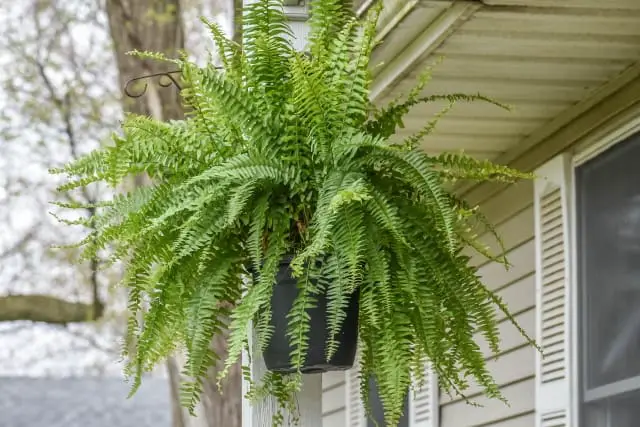
Boston fern
- Nephrolepis exaltata
- Evergreen
- Partial shade
- Height: up to 1 m
- Soil: acid or neutral. Moist, well-drained.
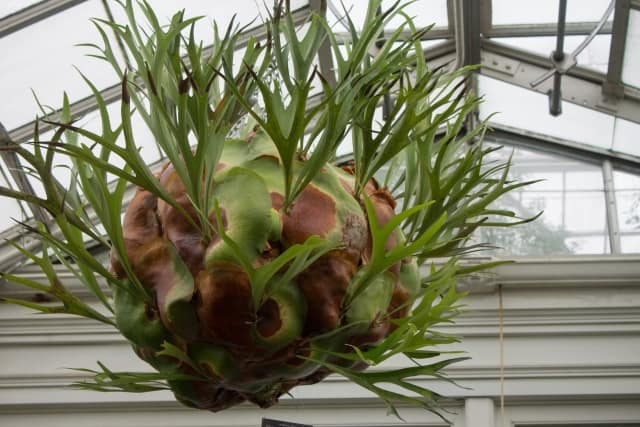
Staghorn fern
- Platycerium bifurcatum
- Evergreen
- Prefers partial shade
- Height: up to 1 m
- Epiphytic (but can be grown on loam). Keep moist, well-drained.
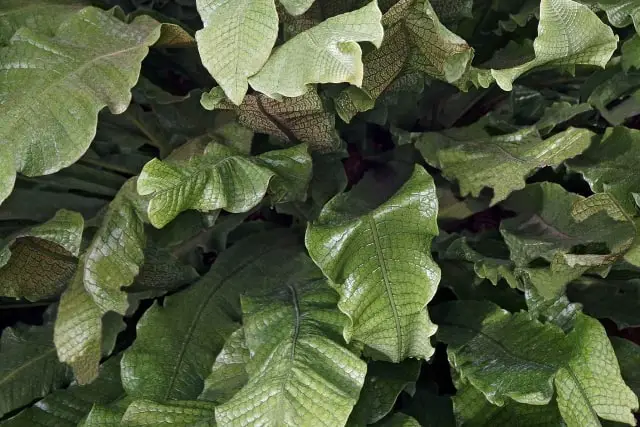
Crocodile fern
- Microsorum musifolium
- Evergreen
- Partial to full shade
- Height: up to 1 m
- Soil: Acid or neutral. Moist, well-drained.
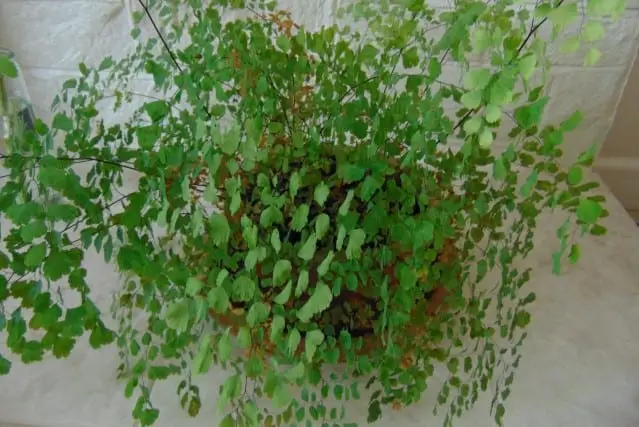
Maidenhair fern
- Adiantum raddianum
- Evergreen
- Partial shade
- Height: up to 0.5 m
- Soil: neutral or alkaline. Moist, well-drained.
Ferns can be very pretty in their own right. You can use them to fill space, act as a companion to flowering plants, or give them center stage.
There is something uniquely pleasing about ferns that make them an asset in any room.
2. They are suited to indoor conditions
Many evergreen varieties of ferns are tropical plants that thrive in warm, temperate conditions. The well-regulated environment of the house provides the perfect temperature.
The biggest challenge for most ferns is that their natural environment is also humid. That can be difficult to replicate in a typical house, and so ferns do need to be well watered, and some steps taken to protect them against very dry air.
First, you can cluster ferns together, or with other house plants, so that they will naturally form a more humid corner. Next, keep them out of drafts and away from sources of dry heat like radiators or vents.
Another strategy is to place the fern on a pebble tray, so that when the water percolates through the pot it soaks the stones rather than leaving the soil moist but well drained. As the water evaporates from the stones, it will increase the local humidity for the fern overhead.
Finally, some fern lovers also swear by misting – giving a quick spray to the fronds to keep their surface damp. It’s not clear how much this does to improve humidity in the long term, but a little pampering certainly can’t hurt.
3. There are plenty of low-maintenance varieties
Some ferns are robust enough to thrive with minimal care. These varieties can cope with occasional dry spells and occasional floods, when watering schedules can be a bit haphazard.
Bird’s nest ferns, Rabbit’s foot ferns, Polypody (or Adder’s fern), Kangeroo paw ferns, and Staghorn are all very tolerant of occasional neglect once established. Perhaps the best beginner fern is the lemon button fern.

Lemon button fern
- Nephrolepis cordifolia (duffii)
- Evergreen
- Partial shade
- Height: up to 0.5 m
- Soil: acid or neutral. Moist, well-drained.
Although related to the more demanding Boston fern, the lemon button fern is famed as a simple, easy and beautiful fern. It even smells good!
There are several factors to bear in mind when choosing an indoor fern. But if you are looking for a fern that will quietly and happily get on with its own thing without needing diligent care and attention, there are plenty of choices available.
4. They grow well where other plants struggle
Ferns like low light and humidity. Most flowering plants like direct sun. If your aim is to decorate your home with plants, many will suffer in those awkward spots – darker corners away from the window, bathrooms, kitchens, or north-facing rooms.
Fortunately, ferns will love it there. The humidity of bathrooms and kitchens will delight them. The north-facing window or gloomy corner is just what they want.
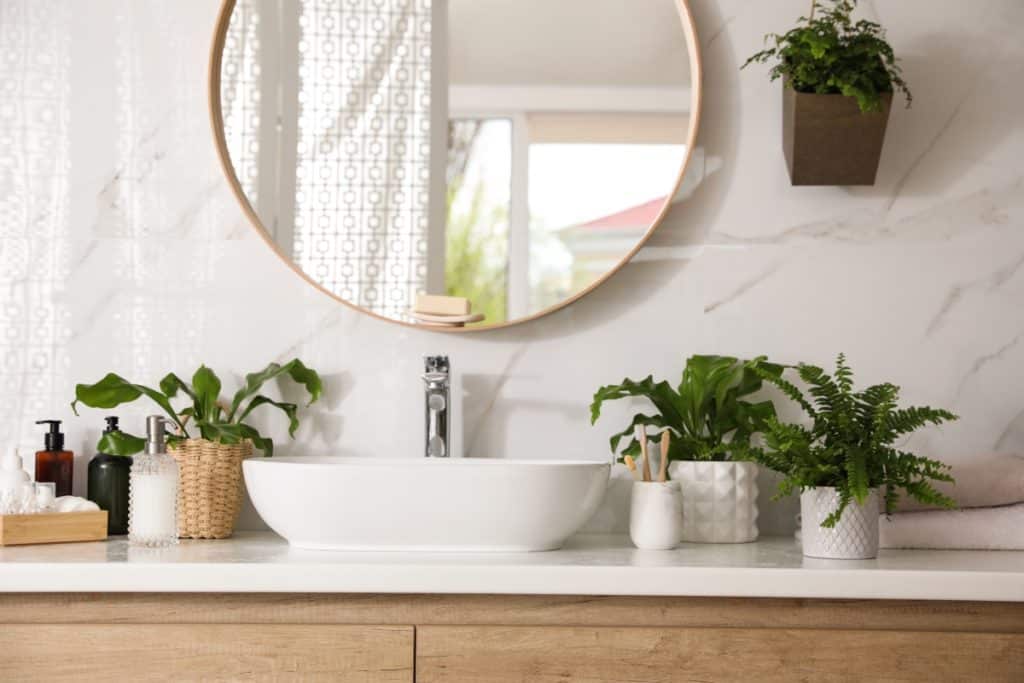
Ferns are tailor made for spaces that are crying out for a splash of nature and life, but where other plants won’t work.
5. They improve air quality
A classic study by NASA in the 1980s showed that ferns are particularly effective among houseplants at clearing pollutants from the air. The study focused on chemicals released by household materials (such as paints and carpets) that are hard to filter by physical means, so a natural alternative is a great option if air quality is a source of worry.
It’s somewhat debatable how the results from a sealed laboratory (or space craft!) would translate into a normal home environment with drafts and open windows and doors, but it’s reassuring to know that as well as adding beauty, ferns will be doing their bit to clean the air in your home.
It all adds to the psychological boost that ferns can bring to our living spaces.
6. The difficult customers
With all those benefits, it is worth mentioning a few challenges that some fern varieties bring. First, the maidenhair fern seems to be most responsible for the “difficult” reputation that ferns can have.
Maidenhairs can be especially sensitive to changes in temperature and humidity. A common problem is when the house heating comes on in fall or winter, and the sudden increase in heat and dryness shocks the fern. The delicate petal-like fronds that once looked so pleasing, turn papery and brown. Sometimes the whole plant can be lost.
Boston ferns are another culprit for sudden loss of vigor. Again, it can be the change in environment that is most damaging. When Boston ferns are taken outside in summer, they can react badly to the change when moved indoors. Equally, an unexpected cold spell can doom them.
The biggest risk for losing more sensitive ferns is the roots drying out. This can spell the end for these plants that are adapted to a tropical, humid climate. To counter this, some sort of automated watering system can be used – and these need not be expensive or complicated. A simple hydrospike works wonders.
Countering that, overwatering ferns can be just as big a problem as underwatering. Fortunately, there are lots of ways to manage the “Goldilocks” conditions without spending a fortune in time or money.
Ferns do not deserve their reputation as difficult plants to grow in the house. In fact, they are perfect for many of the tricky rooms and corners that other plants dislike. As long as you are careful to provide suitable levels of light and water, they will thrive, and add distinctive beauty to your home.
